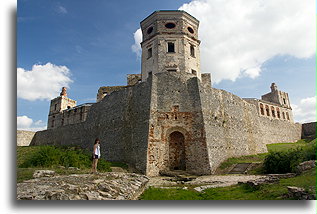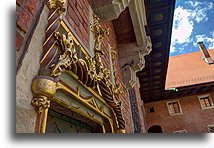The land of the Poles is best known for its pierogi and kielbasa, constantly becoming the battlefield of Europe, and always being chosen first for territorial dismemberment, and vanishing off maps. Based on the decision of other states, new towns appeared within the borders of Poland and other cities with Polish historic heritage are now in other countries. No matter the mistreatment in the 18th to 20th centuries, Poland used to be one of the most powerful and expansive nations in Europe. There is much more to Poland than meets the eye.
1. The First Boomerang
What was once thought to be only used by the Aboriginal Australians is now recognized to be first invented by inhabitants in Europe. A boomerang crafted from a mammoths tusk was found in a cave in the Carpathian Mountains in Poland. It is the oldest of this type of weapon in the world, older than their Australian counterparts are. The oldest discovered Aboriginal boomerangs are dated to be about 10,000 years old, while radiocarbon dating in boomerang from Poland shows that it is more than 23,000 years old. The boomerang itself is the first man-made object to theoretically fly and return to a thrower.
2. The Battle of Grunwald (Tannenburg)
The Battle of Grunwald was an historic clash between the Polish-Lithuanian Commonwealth and the Teutonic Order, On July 15, 1410, this single collision of forces changed the balance of power in Eastern Europe and was the beginning of Polish domination as a political and military power in the region. Despite the defeat and heavy losses, the Order maintained much of its territory after the war with the Polish. However, because of their numerous defeats, it never regained its prominence as a powerful military force. The casualties of the battle were in truth higher in number for the Crown and their allies, but about 14,000 Teutonic knights were killed or taken captive and 80% of all its command, including both the Grand Master and Grand Marshal, who died in the Battle of Grunwald.

5. Winged Hussars
One of the most dangerous and most distinguished cavalry units in history were the Polish Winged Hussars. In military power, they led in the European continent since the end of 16th century to the late 17th century. They were known for their ostrich feathers that stretched on their backs to over their heads. In 1605, numbering only 2,500 Polish hussars was able to defeat 11,000 Swedish pikemen! Werent pikemen the special units to fight the heavy cavalry? Well, the winged hussars simply out-piked the pikemen! Each rider was armed with a 20-foot / 6 m lance, longer than the average European pike carried by the infantry. As armament, hussars also carried a sword, gun, and steel armor.
6. Swedish Deluge
The little known mid-17th-century mass-scale invasion by the Swedes which broke apart the strong Polish-Lithuanian Commonwealth and removed it as a major power in Europe. During so called the Deluge, the Polish nation lost approximately one third of its population with an estimated 4 million dead. This short five-year conflict ranks in the top 15 the bloodiest wars in worlds history. This war brought massive destruction and pillaging. The main reason behind the invasion for the Swedes was the need to pay troops and mercenaries that were in military service after the Thirty Years War. There is no better way to pay the troops than to invade and pillage a rich neighboring country. A little known is the fact that the destruction of Poland was more extensive than after World War II. Swedish invaders destroyed 188 cities and towns, 81 castles, and 136 churches in Poland. The Swedes completely destroyed Polish capital of Warsaw. Out of a pre-war population of 20,000, only 2,000 remained in the city after the war. Most of the gold and riches that have been stolen during the Swedish Deluge are still in Swedish museums and private collections, and the value of works of art is estimated today at about 1.3 billion US dollars. (see Krzyżtopór).

7. Bagel
What is bagel doing on the list? When someone says bagel, two words come to mind: Jewish and New York City. What is little known is that in reality the bagel was invented in Poland in the early 17th century. There have been stories that it was created in the shape of a stirrup to commemorate the Polish victory over the Ottomans at the Battle of Vienna in 1683, but the bagel had already existed in Jewish communities throughout Poland for many years earlier. However, it is true that it was it invented by Jewish bakers living in Kraków, the capital of Poland at the time and not in the metropolis of New York City. The name itself, bagel, comes from the Yiddish language. The word “beygal” means “ring” or “bracelet.” Emigrants from Poland brought this idea to the United States and Canada in the mid-1800s.

8. Kerosene and Oil Refining
Ignacy Lukasiewicz, as an inventor, he had a very impressive portfolio of great achievements. The largest of his inventions is the method of distilling kerosene from seep oil naturally found on the surface of the ground. His new means of producing kerosene began its rise to prominence and use in Europe and started the shift away from the common, but inefficient whale oil. With the start of the use of kerosene, Lukasiewicz developed an improved lamp that worked better with the new oil. On July 31, 1853 he donated his newly designed kerosene lamps to the General Hospital in Lwow, where they were used for the first time during an urgent surgery at night. This date is accredited as the birth of the oil industry.
9. Win against communism twice!
Poland regained its status as an independent state at the end of the First World War. After the partition of its territory by Russia, Prussia and Austria in 1795, Poland was wiped off the map of Europe for exactly 123 years, until 1918. As seen in the countrys history, for centuries Poland was ongoing disputes with Russia, which was trying to expand its sphere of influence in the west of the European continent. With the rise of communism, the pressure has become even stronger. In 1920, in only the second year of its independence, Poland faced Russians invader again. In case of winning the war, the Soviets wanted to create Polish communist republic as part of Russia. In the battle of Warsaw, at a turning point Polish-Bolshevik war, Poland paralyzed Lenin's Red Army, halting its expansion, which aim was to introduce the communist spirit in the industrialized Germany. Polish forces lost about one third of their 100,000 soldiers, while more than a quarter of Russians perished or been taken prisoner. It was a great success for the Poles over communism, until now the underestimated victory that delayed the formation of the communist Germany for 25 years.
Polish second victory over communism was accomplished with help of famous Solidarity movement and its leader Lech Walesa. It was a revolt against the Communist Party, which controlled the Polish government under the Russian sphere of influence. The independent labor union as non-communist organization brought over a third of all workers in the nation. It was the first mass-scale stand against the grasp of Russia's embrace. That initiated changes that led to the destruction and finally collapse of communism in all Eastern European countries.
10. First to Break the German Enigma
Thanks to the film “The Imitation Game,” the famous English mathematician who broke the secret of 5-rotor Enigma coding machines, has risen to even more fame and renown. Whenever we hear the word Enigma, Turing is a name that comes first to mind. In fact, a Polish mathematician Marian Rejewski was the first who broke the Enigma as early as 1932. In 1938, in order to automate breaking the ciphers, he developed a device described as a cryptologic bomb. It consisted of six linked together Polish copies of Enigma. A few months before the outbreak of World War II, the Poles handed copies of Polish-reconstructed Enigma machines with documentation to the intelligence agencies of Britain and France.




